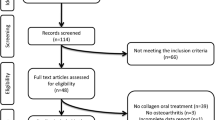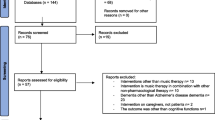Abstract
Background
Meniere’s disease (MD) is a complex disease that can severely affect the quality of life. In this systematic review and meta-analysis, we aimed to investigate the effect of vestibular rehabilitation (VR) versus control/other interventions on the quality of life in patients with MD.
Methods
We searched six electronic databases (PubMed/MEDLINE, Web of Science, EMBASE, Scopus, ProQuest, CENTRAL) from inception to September 30, 2022 with no language restriction for publications comparing the effect of VR with control/ other interventions in patients with MD. The primary outcome was quality of life assessed by dizziness handicap inventory (DHI).
Results
Overall, three studies with a total of 465 patients were included in the meta-analysis. All the included studies reported immediate-term DHI scores. A medium effect (standardized mean difference [SMD] = − 0.58, 95% confidence interval [CI] − 1.12; − 0.05) was observed favoring the use of VR to improve DHI scores in patients with MD in the immediate term. Moreover, there was severe heterogeneity in immediate DHI scores among the included studies (χ2 = 22.33, P = 0.00, I2 = 82.1%).
Conclusions
VR rehabilitation can improve the quality of life in patients with MD immediately after treatment. Since all the included studies had a high risk of bias and none had long-term follow-ups, further high-quality research is required to determine the short-, intermediate-, and long-term effects of VR compared to control/other interventions.




Similar content being viewed by others
Availability of data and materials
The datasets used and/or analyzed during the current study are available from the corresponding author upon reasonable request.
References
Nakashima T, Pyykkö I, Arroll MA, Casselbrant ML et al (2016) Meniere’s disease. Nat Rev Dis Primers 2(1):1–18
Lopez-Escamez JA, Carey J, Chung W-H, Goebel JA, Classification committee of the barany society; Japan society for equilibrium research; european academy of otology and neurotology (EAONO); equilibrium committee of the American academy of otolaryngology-head and neck surgery (AAO-HNS); Korean balance society et al (2015) Diagnostic criteria for Meniere’s disease. J Vestib Res 25(1):1–7
Flook M, Lopez Escamez JA (2018) Meniere’s disease: Genetics and the immune system. Curr Otorhinolaryngol Rep 6(1):24–31
Frejo L, Soto-Varela A, Santos-Perez S, Aran I et al (2016) Clinical subgroups in bilateral Meniere disease. Front Neurol 7:182
Frejo L, Martin-Sanz E, Teggi R, Trinidad G et al (2017) Extended phenotype and clinical subgroups in unilateral Meniere disease: a cross-sectional study with cluster analysis. Clin Otolaryngol 42(6):1172–1180
Lopez-Escamez JA, Batuecas-Caletrio A, Bisdorff A (2018) Towards personalized medicine in Ménière’s disease. F1000Research. 7:F1000 Faculty Rev-1295. https://doi.org/10.12688/f1000research.14417.1
Nevoux J, Barbara M, Dornhoffer J, Gibson W, Kitahara T, Darrouzet V (2018) International consensus (ICON) on treatment of Ménière’s disease. Eur Ann Otorhinolaryngol Head Neck Dis 135(1):S29–S32
Magnan J, Özgirgin ON, Trabalzini F, Lacour M et al (2018) European position statement on diagnosis, and treatment of Meniere’s disease. J Int Adv Otol 14(2):317
Sulway S, Whitney SL (2019) Advances in vestibular rehabilitation. Vestibular Disord 82:164–169
van Esch BF, van der Scheer-Horst ES, van der Zaag-Loonen HJ, Bruintjes TD, van Benthem PPG (2017) The effect of vestibular rehabilitation in patients with Ménière’s disease: a systematic review. Otolaryngol-Head and Neck Surg 156(3):426–434
Liberati A, Altman DG, Tetzlaff J, Mulrow C et al (2009) The PRISMA statement for reporting systematic reviews and meta-analyses of studies that evaluate health care interventions: explanation and elaboration. J Clin Epidemiol 62(10):e1–e34
Lopez-Escamez JA, Carey J, Chung WH, Goebel JA et al (2016) Diagnostic criteria for Menière’s disease. Consensus document of the Bárány Society, the Japan Society for Equilibrium Research, the European Academy of Otology and Neurotology (EAONO), the American Academy of Otolaryngology-Head and Neck Surgery (AAO-HNS) and the Korean Balance Society. Acta Otorrinolaringol Esp 67(1):1–7
Higgins JPT, Altman DG, Gøtzsche PC, Jüni P et al (2011) The Cochrane Collaboration’s tool for assessing risk of bias in randomised trials. BMJ 343:d5928. https://doi.org/10.1136/bmj.d5928
Higgins JPT, Thomas J, Chandler J, Cumpston M et al (2019) Cochrane handbook for systematic reviews of interventions. Wiley
Higgins JPT, Thomas J, Chandler J, Cumpston M, Li T, Page MJ, Welch VA (eds) (2019) Cochrane handbook for systematic reviews of interventions, 2nd edn. John Wiley & Sons, Chichester, UK
Cohen J (1992) Statistical power analysis. Curr Dir Psychol Sci 1(3):98–101
Yardley L, Kirby S (2006) Evaluation of booklet-based self-management of symptoms in Ménière disease: a randomized controlled trial. Psychosom Med 68(5):762–769
Liu JL, Liu JG, Chen XB, Liu YH (2020) The benefits of betahistine or vestibular rehabilitation (Tetrax biofeedback) on the quality of life and fall risk in patients with Ménière’s disease. J Laryngol Otol 134(12):1073–1076
Egger M, Smith GD, Schneider M, Minder C (1997) Bias in meta-analysis detected by a simple, graphical test. BMJ 315(7109):629–634
Duval S, Tweedie R (2000) Trim and fill: a simple funnel-plot–based method of testing and adjusting for publication bias in meta-analysis. Biometrics 56(2):455–463
Patsopoulos NA, Evangelou E, Ioannidis JPA (2008) Sensitivity of between-study heterogeneity in meta-analysis: proposed metrics and empirical evaluation. Int J Epidemiol 37(5):1148–1157
Antonenko LM, Parfenov VA (2018) Non-drug therapy of vertigo. Zh Nevrol Psikhiatr Im S S Korsakova 118(8):38–42
Gottshall KR, Hoffer ME, Moore RJ, Balough BJ (2005) The role of vestibular rehabilitation in the treatment of Meniere’s disease. Otolaryngol Head Neck Surg 133(3):326–328
Hahn ISKSACA (2001) Visuo-vestibular biofeedback in patients with peripheral vestibular disorders. Acta Otolaryngol 121(545):88–91
Perez N, Santandreu E, Benitez J, Rey-Martinez J (2006) Improvement of postural control in patients with peripheral vestibulopathy. Eur Arch Oto-Rhino-Laryngol Head Neck 263(5):414–420
Nyabenda A, Briart C, Deggouj N, Gersdorff M (2003) Benefit of rotational exercises for patients with Meniere’s syndrome, method used by the ENT department of St-Luc university clinic. Annales de readaptation et de medecine physique revue scientifique de la Societe francaise de reeducation fonctionnelle de readaptation et de medecine physique 46(9):607–614
Socher DD, Socher JA, Azzi VJB (2012) Evaluation of quality of life pre-and post-vestibular rehabilitation in patients with benign paroxysmal positional vertigo associated with Meniere’s disease. Int Arch Otorhinolaryngol 16(04):430–436
Wang J, Gong J, Sui X, Wang L, Zhu L, Sun D (2021) An effect analysis of vestibular rehabilitation training in vertigo treatment. Am J Transl Res 13(4):3494
Zhuang Y, Wu P, Li W, Xi S (2022) The effectiveness of vestibular rehabilitation in Ménière’s disease patients with chronic imbalance. Lin chuang er bi yan hou tou jing wai ke za zhi J Clin Otorhinolaryngol Head Neck Surg 36(9):675–884
Garcia AP, Ganança MM, Cusin FS, Tomaz A, Ganança FF, Caovilla HH (2013) Vestibular rehabilitation with virtual reality in Ménière’s disease. Braz J Otorhinolaryngol 79(3):366–374
Hsu S-Y, Fang T-Y, Yeh S-C, Su M-C, Wang P-C, Wang VY (2017) Three-dimensional, virtual reality vestibular rehabilitation for chronic imbalance problem caused by Ménière’s disease: a pilot study. Disabil Rehabil 39(16):1601–1606
Caruso S, Mauro D, Maiolino L, Grillo C, Rapisarda AMC, Cianci S (2018) Effects of combined oral contraception containing drospirenone on premenstrual exacerbation of Meniere’s disease: preliminary study. Eur J Obstet Gynecol Reprod Biol 224:102–107
Hillier SL, McDonnell M (2011) Vestibular rehabilitation for unilateral peripheral vestibular dysfunction. Cochrane Database Syst Rev 2:Cd005397
McDonnell MN, Hillier SL (2015) Vestibular rehabilitation for unilateral peripheral vestibular dysfunction. Cochrane Database Syst Rev. https://doi.org/10.1002/14651858.CD005397.pub4
Yeh S-C, Chen S, Wang P-C, Su M-C, Chang C-H, Tsai P-Y (2014) Interactive 3-dimensional virtual reality rehabilitation for patients with chronic imbalance and vestibular dysfunction. Technol Health Care 22(6):915–921
Eleftheriadou A, Skalidi N, Velegrakis GA (2012) Vestibular rehabilitation strategies and factors that affect the outcome. Eur Arch Otorhinolaryngol 269(11):2309–2316
Margani V, Pascucci S, Talamonti R, Serani E, Bini F, Marinozzi F, Volpini L, Elfarargy HH, Covelli E, Barbara M (2023) Augmented virtual reality in vestibular assessment: a dynamic gait application. Audiol Neurotol. https://doi.org/10.1159/000529993
Acknowledgements
We sincerely appreciate the dedicated efforts of the personnel at the Neuromusculoskeletal Research Center, Iran University of Medical Sciences, Tehran, Iran.
Funding
The current study received no funding.
Author information
Authors and Affiliations
Contributions
Conceptualization and study validation: AR. Implementation and supervision: HA. Data analysis and interpretation: ZF. Writing and reviewing: MM.
Corresponding author
Ethics declarations
Conflict of interest
The authors declare that they have no competing interests.
Ethics approval and consent to participate
The study received ethics approval from the Ethics Committee of Isfahan University of Medical Sciences under the ethics code.
Consent for publication
Not applicable.
Additional information
Publisher's Note
Springer Nature remains neutral with regard to jurisdictional claims in published maps and institutional affiliations.
Supplementary Information
Below is the link to the electronic supplementary material.
Rights and permissions
Springer Nature or its licensor (e.g. a society or other partner) holds exclusive rights to this article under a publishing agreement with the author(s) or other rightsholder(s); author self-archiving of the accepted manuscript version of this article is solely governed by the terms of such publishing agreement and applicable law.
About this article
Cite this article
Rezaeian, A., Abtahi, H., Moradi, M. et al. The effect of vestibular rehabilitation in Meniere’s disease: a systematic review and meta-analysis of clinical trials. Eur Arch Otorhinolaryngol 280, 3967–3975 (2023). https://doi.org/10.1007/s00405-023-08066-x
Received:
Accepted:
Published:
Issue Date:
DOI: https://doi.org/10.1007/s00405-023-08066-x




